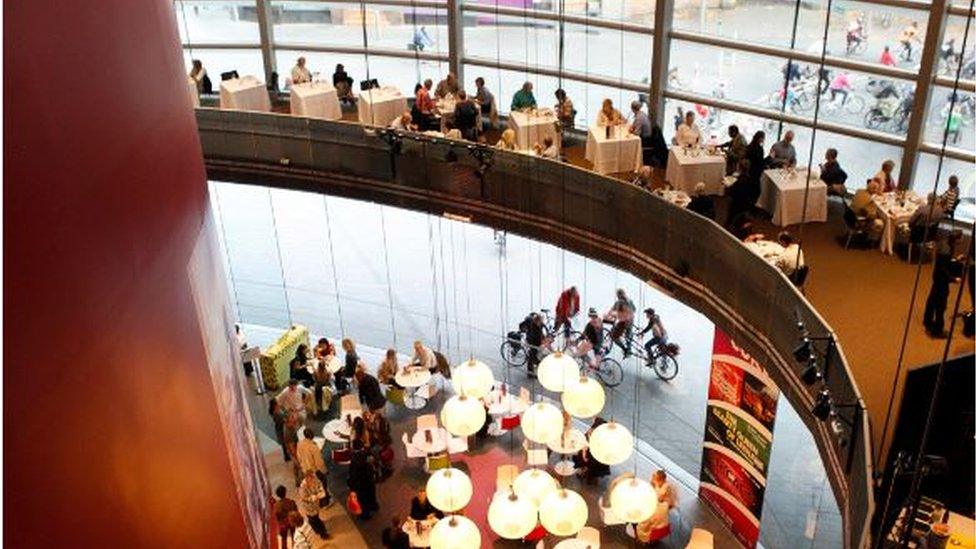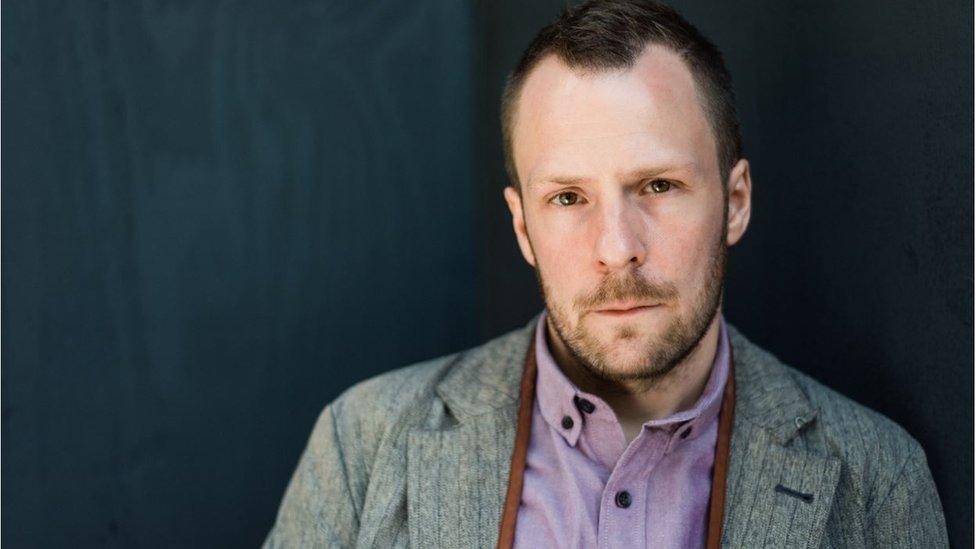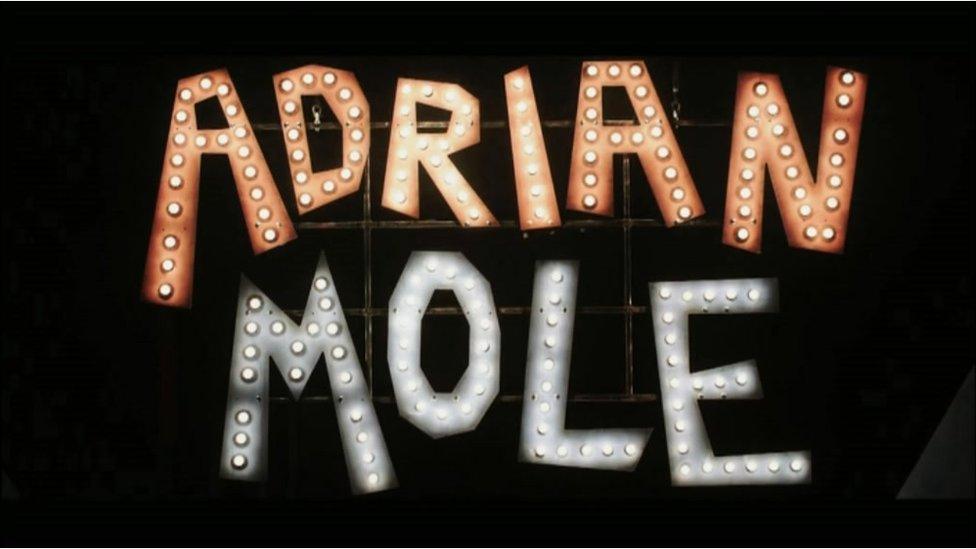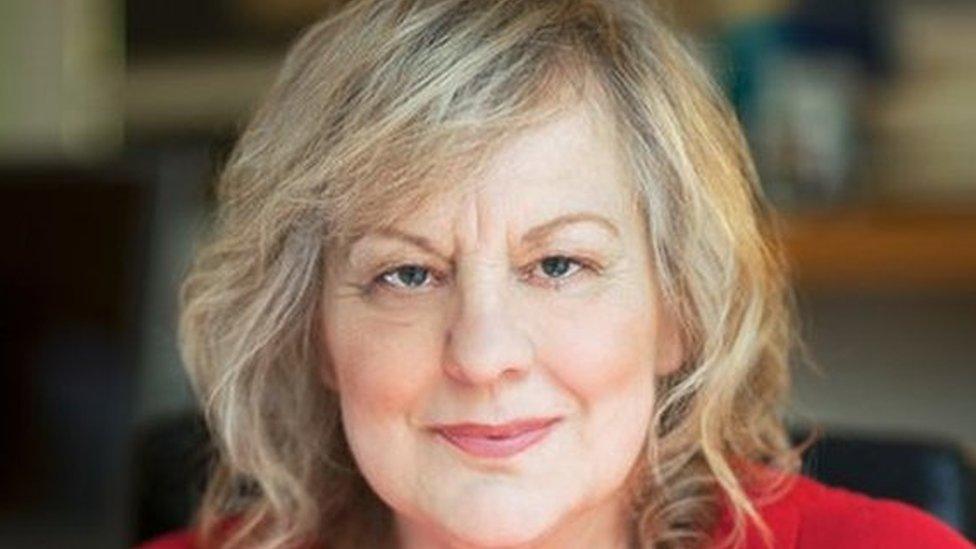The Curve, Leicester: The 'expensive disaster' that came back
- Published

Once seen as an expensive disaster, the Curve is now raising Leicester's profile
Once condemned as an "expensive disaster", the Curve Theatre in Leicester now stands in the top 10 venues of its kind in the country. How did it manage to turn things round?
"Charmless" and "completely out of control".
These were just some of the less-than-complimentary verdicts passed on Leicester's Curve Theatre when it opened its doors in 2008.
By the time the Queen cut the ribbon in the foyer of the futuristic glass and steel edifice, designed by Rafael Viñoly, the project had spiralled £35m over budget to a cost of £61m.
"In terms of cost control, it was absolutely disastrous.
"I don't think there's ever been a council-sponsored project that has been so drastically over-budget and so completely out of control," said Leicester's mayor, Sir Peter Soulsby.

The Curve's design "felt like an airport", according to critics
"Originally the council had expected to put in less than £5m and ended up having to put in the best part of £40m."
In addition, some critics were unconvinced about the Curve's avant-garde architecture and branded its first major home-grown production "puerile".
"Public parts of the building are charmless. And it feels like an airport," complained Daily Mail critic Quentin Letts.
Yet despite such inauspicious beginnings, the Curve has managed to carve out a place for itself as one of the top 10 producing theatres in the country, according to The Stage newspaper, with an annual income of almost £5m.
Audience numbers are up, with 100 new seats being installed to accommodate extra demand.
So how has the venue managed such a transformation - particularly in an era of arts funding cuts and theatre closures?

Nikolai Foster, the theatre's artistic director, believes its future lies in musicals
Alistair Smith, editor of The Stage, believes part of the reason for the Curve's success has been its high-quality productions, which have won a national reputation.
"I think the Curve had a few rocky years when it first opened," he said.
"But over the last two or three years, it has really won people over and started to get national recognition for the quality of its work.
"It's now in the top tier of regional producing houses."
Those behind the scenes at the theatre put its success down to a focus on high-quality, home-grown content and a commercial savviness which, together, brought in £4.8m in 2014-15.
This compares to £3.4m at the Birmingham Repertory Theatre and £6.5m at the West Yorkshire Playhouse.

The theatre used British writers to develop a musical, based on Leicester writer Sue Townsend's famous books
Fiona Allan, the Curve's former chief executive, said: "People weren't fond of us and part of that was all the negativity and all the press around the building costs.
"Something I set out quite actively with my team to do was to engage with people better.
"It feels fantastic to have proven the nay-sayers wrong. A lot of people said from the outset Curve could never succeed and now we're one of the leading producing theatres in the country."
One of the most significant productions to have graced the Leicester stage was a musical version of Adrian Mole, based on the novels by Sue Townsend.
The writer, who was from Leicester, worked on the musical before her death in April 2014.

Sue Townsend worked on the musical of Adrian Mole prior to her death
The production, which ran from 7 March to 4 April, attracted audiences of 18,000 and the theatre is now in negotiations for a possible West End run.
Not everybody was impressed with the show, which Mr Letts described as "puerile and blasphemous" - epithets that the Curve put on its posters for the show.
"I think the last musical that transferred was Loserville in 2012 from the West Yorkshire Playhouse, so it does happen occasionally," said Mr Smith. "It would certainly be an achievement."
Danish-born Nikolai Foster, who was appointed as the Curve's artistic director in January 2015, now sees the theatre's future as lying in musicals.

The theatre drew on Quentin Letts' criticism for its publicity campaign
Mr Foster, whose track record includes working as a director at the Crucible Theatre in Sheffield and associate director at the West Yorkshire Playhouse in Leeds, said: "Musicals engage diverse groups of people.
"They cut through a lot of stuff a play by Shakespeare or Ibsen can't necessarily do.
"I want to do more musicals here. I want to make Curve the centre of new British musicals."
Not everybody views this idea with quite the same enthusiasm.
Will Gompertz, the BBC's arts editor said: "The thing about musicals is they are wonderful if you hit the bullseye because they will make you money for forever and a day, but hits versus misses is an ugly statistic.
"Hats off to him and I hope it works."
Cameras filmed rehearsals for the musical version of Adrian Mole
The theatre was also quick to spy the commercial potential of its venue, with takings standing at £900,000 in 2014-15.
This compares with the £216,526 taken by the Birmingham Rep.
For the past three years, it has hosted the graduation ceremony for Leicester's De Montfort University.
"Commercially speaking, that is our biggest event of the year," said Alex Bliss, events co-ordinator.
"It runs for 10 days and it has the full-scale range of a theatrical production."
In 2009-10, 58% of the Curve's income came from public subsidy - now that stands at 33%.
"Most theatres are doing an incredibly good job of surviving at the moment, despite the cuts," said Mr Smith.
"But if more cuts come in, which looks likely, there could be problems.
"A number of theatres across the country are trying to find more innovative ways of raising money to help support their core programme.
"The Curve has been very good at that. It's a good example of a theatre that is doing that really well."

The theatre hosts a graduation ceremony - its biggest commercial event
The theatre is even starting to win around some of its detractors.
Despite his initial doubts, Leicester's mayor, Sir Peter, said: "What it has done, incredibly successfully, is connect with Leicester and Leicestershire people, by way of the quality of productions it has put on.
"And it's raised the profile of the city."
Even arch-critic Mr Letts is prepared to concede that the appointment of Nikolai Foster has "improved matters" at the Curve.
"The great potential of theatre is to bring the arts into a city like Leicester, creating a sense of community," he said. "The Curve might yet do that."
For more, watch On Stage At Curve on BBC One East Midlands at 19:30 on Monday 9 November and nationwide for 30 days thereafter on the iPlayer.
- Published8 March 2015
